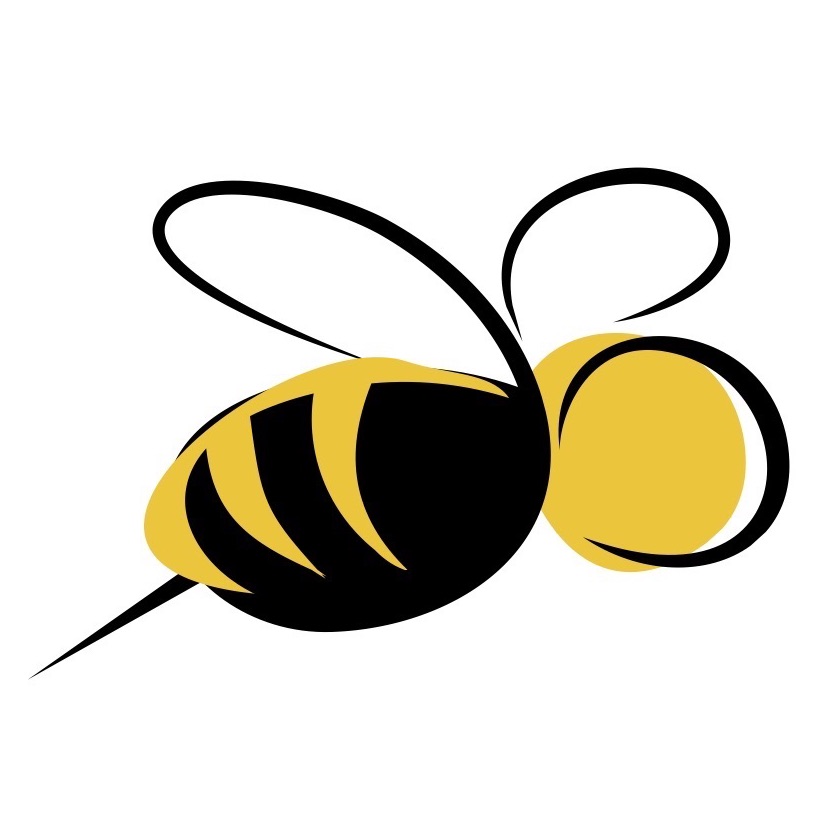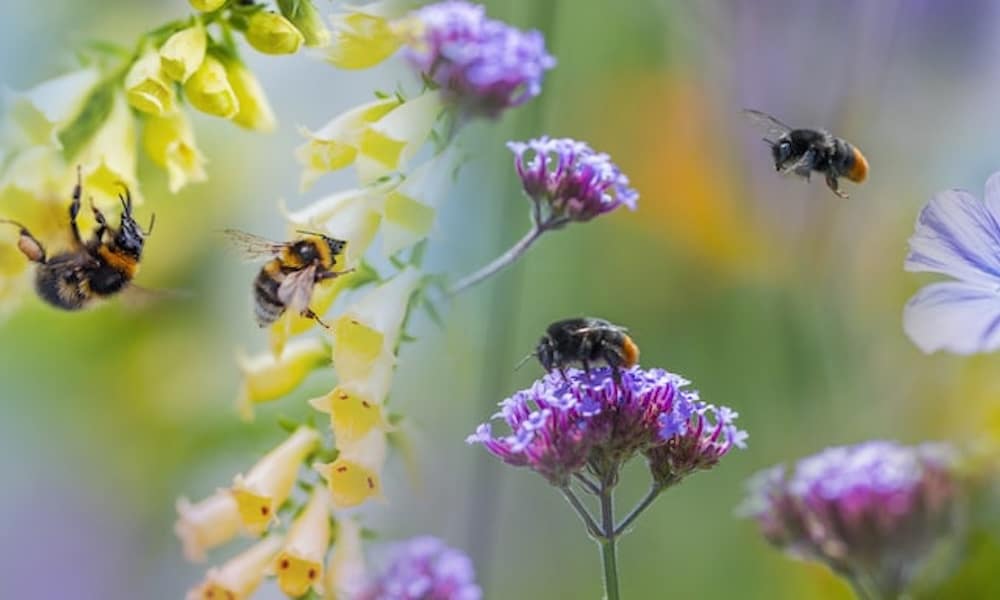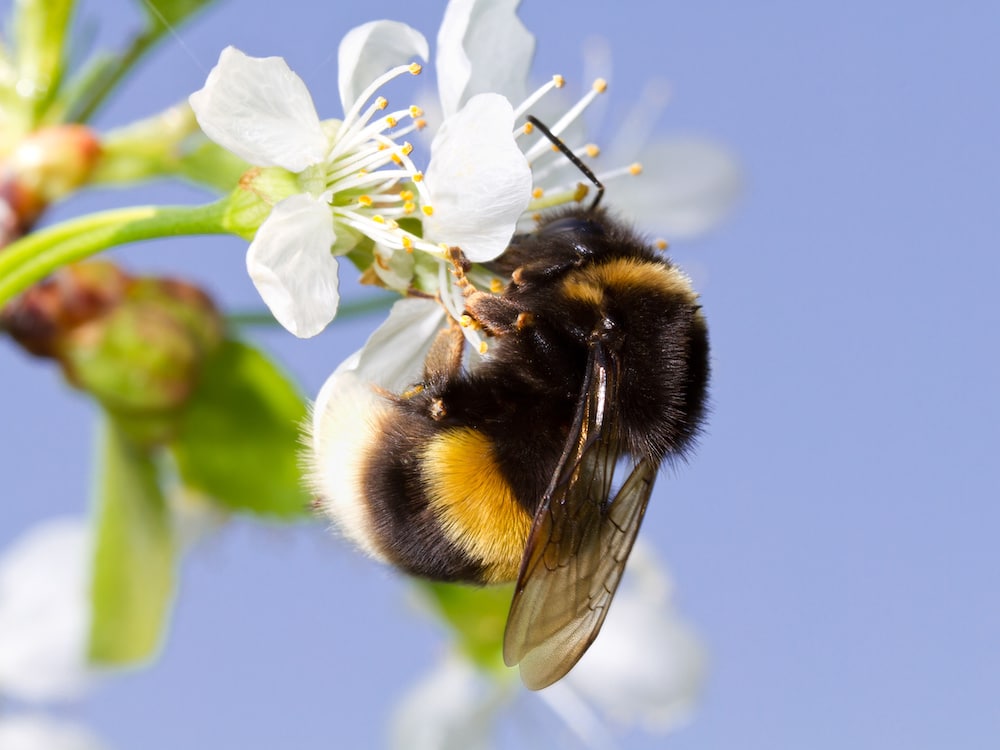What Other Kinds of Bees Pollinate Plants?
Although honeybees are the world’s sweethearts, they’re not the only ones that carry pollen from flower to flower. There are many species of bees that pollinate flowers, trees and crops, so I decided to explore a few of those that do. First, a few important things to note about bees:
- Bees are bees, hornets are hornets and wasps are wasps – just because they are yellow with black stripes (or is that black with yellow stripes) doesn’t make them all bees. Bees, hornets and wasps are different insects and only distantly related to each other.
- Bees are generally more fuzzy or hairy, while flies, hornets, and wasps have little to no hair. Yellow Jackets may look very similar to Honeybees but Yellow Jackets have no hair and do not pollinate – they are carnivorous and will eat meat, fruit, and anything really.
- Female bees usually always carry the pollen. You can see it clumped onto their legs or fuzzy bellies.
- There are two kinds of bees – Social bees and Solitary bees.
- Social bees live together in hives ruled by queens. Only social “honey bees” make honey – solitary bees do not.
- Solitary bees only collect nectar and pollen to feed their broods. Solitary bees live alone, however some will live in little underground holes near each other. Either way, they both pollinate fruits and vegetables as well as decorative flowers and other plants.
Now, let’s check out 8 types of bees who also pollinate plants:
1. Bumblebee (genus: Bombus)
Of all the bees my favorites are the Bumbles. There’s just something about their fat little furry bodies flying around that always makes me smile – in my opinion “Bombus” is the perfect genus name for this very bombly bee – lol!
Description. Bumblebees are big, about 3/4″ – 1 inch long but are smaller than Carpenter bees. Their entire bodies are black and covered with thick yellow and black hair. The wings of bumblebees are translucent black and beat very quickly allowing them to move so fast inside the flower that it creates a vibration called “buzz pollination” which causes the pollen to literally shake right on (and off) their hair. Bumblebees have 4 wings, 2 on each side.
Habitats: Social Bees – Queens and Colonies: Bumblebees are ruled by a queen. They live in very small colonies made up of only a few dozen bees as opposed to the hundreds of bees in honeybee colonies. They build their colonies and nests underground; sometimes in abandoned animal dens, or those they’ve built themselves.
Do Bumblebees sting? Like most bees bumbles can sting, but being non-aggressive they are rarely interested in doing so unless someone gets too close to the nest or tries to handle them. They might look all cute and fuzzy but beware, it’s best to just watch and not touch.
Pollination: In the agricultural world, they are used to pollinate crops such as tomatoes, squash, cucumbers, melon, strawberries, blueberries and many others. They also pollinate a wide variety of wildflowers. As with the honeybee, it’s the female workers that you see out collecting pollen on their back legs.
Do Bumblebees make honey? Bumblebees do not make honey as such. They gather nectar for the short-term that is stored in little cells to feed the larvae of the next brood. These bees do not winter over. At the beginning of the new season, only one new queen will usually emerge after all the other males, females and the old queen have died.
2. Southeastern Blueberry bee (Habropoda laboriosa)
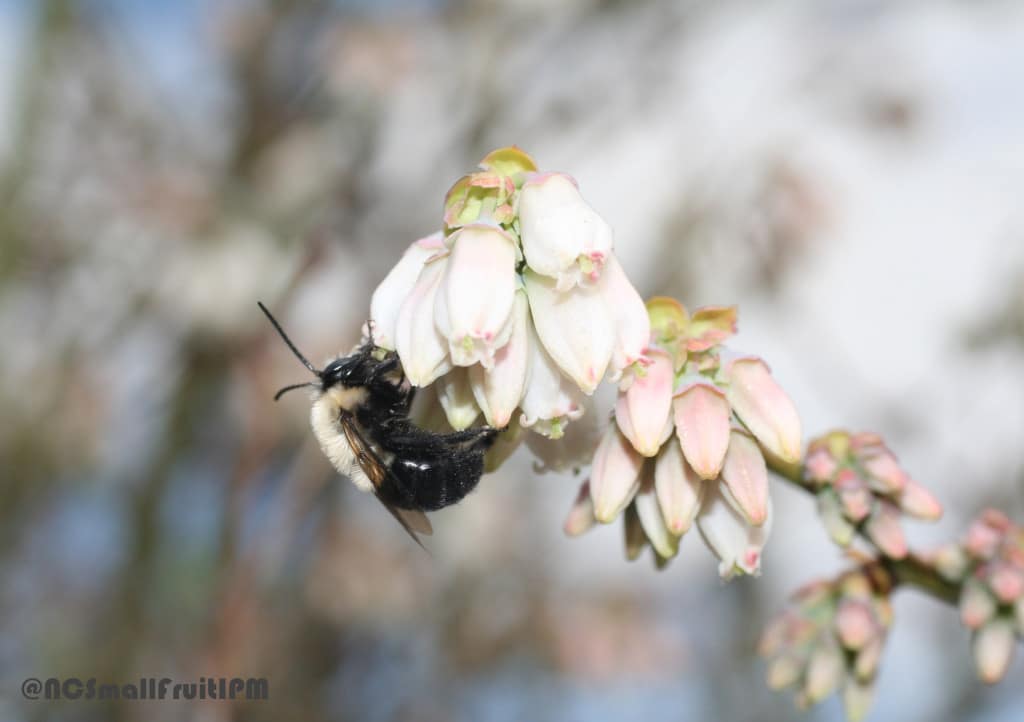
Description: Southeastern Blueberry Bees may look like Bumblebees except that are very small and much faster. Their size is close to that of a honeybee and perfect for getting into tiny blueberry blossoms. They have furry yellow faces and backs with shiny black butts. In the southern regions of the United States they are only active for a few short weeks during the blueberry flowering season from March into April.
Habitats – Solitary Bees: Blueberry bees are solitary ground nesting bees. They dig little burrows in loose or sandy soils and even have been know to live under the loose soil of fallen trees and leaves.
Pollination: Blueberry Bees are also “buzz pollinators”. They are the primary bee that pollinate blueberries. When inside the tubular flower she will hold onto the male part of the flower called the anther and due to the extreme vibrating motion of her wings the pollen will fall out of the anther right onto her. Then, when she moves to the next flower to repeat the process by buzz vibrating again, the pollen that is already on her from previous flowers will also shake out to cover the stigma (the female part of this new flower) thus pollenating it into creating those luscious blueberries we all love so much.
Do Blueberry Bees Sting? Blueberry bees are not aggressive and rarely sting unless handled or stepped on.
3. Eastern Carpenter Bees: (genus: Xylocopa varipuncta)
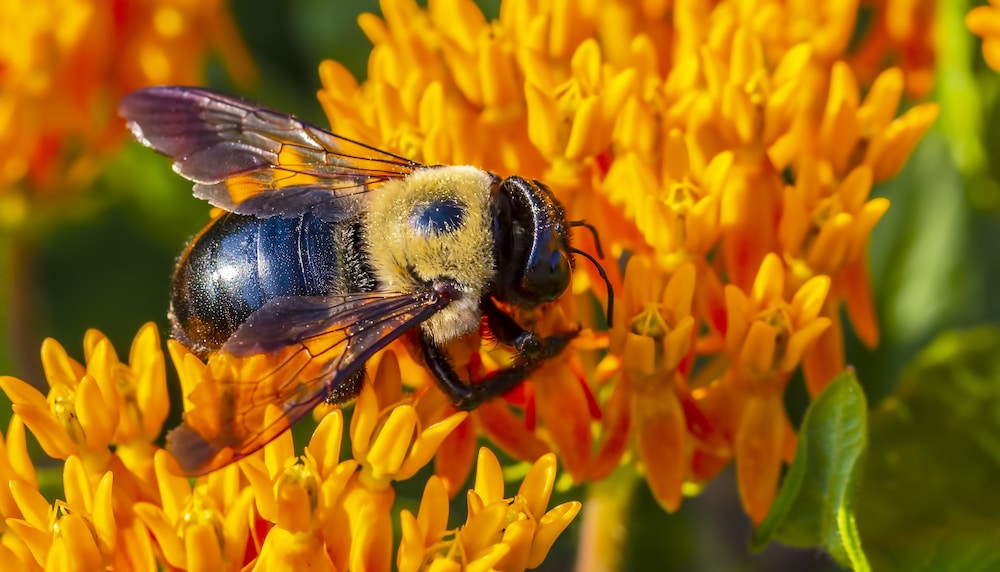
When these bees zoom past your head you know you’ve been buzzed! I had one shoot past me once and not only could I hear the buzz of it’s giant wings but I felt a tiny yet mighty wind blow by!
Description: The Carpenter Bee is huge! They can grow up to 1-1/2 inches in length (3.81cm). Although much larger, they do resemble the Bumbles however, there are distinct differences. Eastern Carpenter females have dense yellow hairs on their backs with a black spot between their wings (shown above), while the female Valley Carpenter bee (from Texas into California) is completely black.
The Valley Carpenter males are rarely seen (shown below) but are quite unforgettable as they are very large and covered in brownish-yellow hair with green eyes.
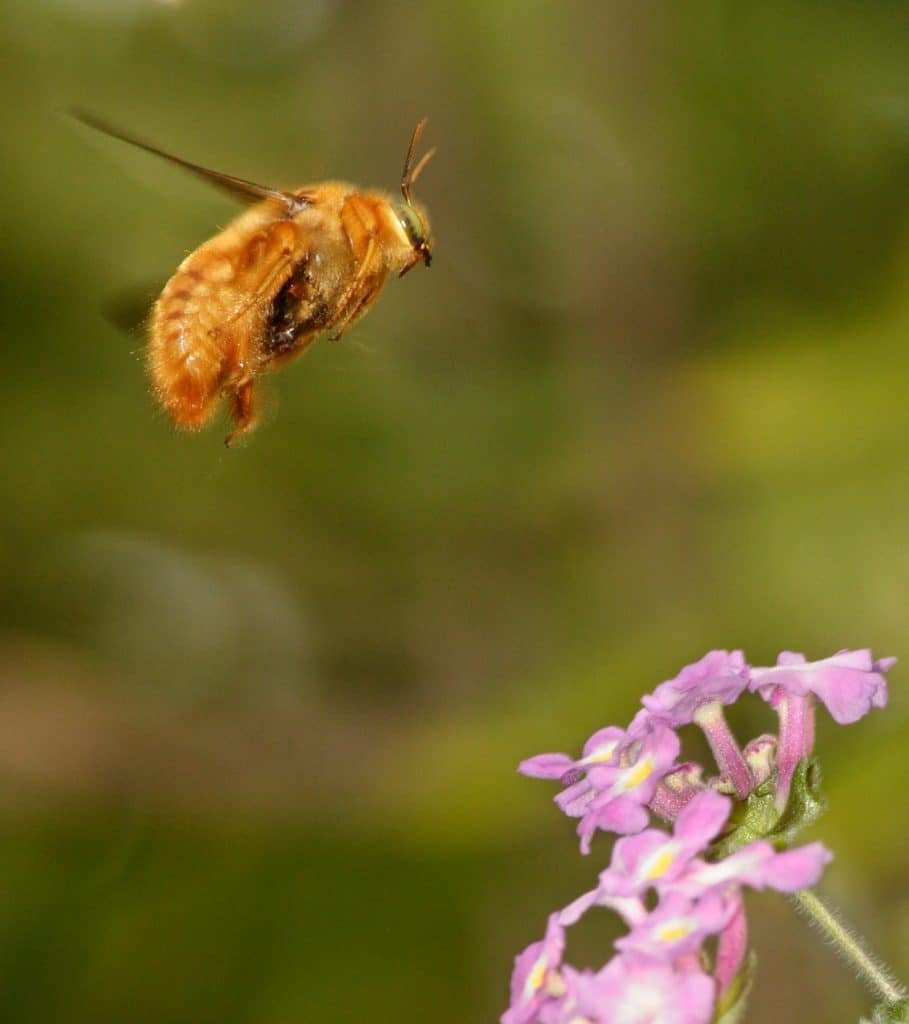
Male Valley Carpenter bee. Photo by: Matthew Field
Habitats – Solitary Bees: Most Carpenter bees are considered solitary but there are also some who are more social wherein the mother /daughter will co-exist to raise the next generation. Carpenter bees of all kinds can make their nests in burrows or in soft wood tubes preferring the limbs of trees or in the wood frames of buildings. They don’t eat wood, instead they excavate tunnels by boring into the wood to create shelters and to raise their young. Males and females will hibernate in the tunnels in the winter.
Pollination: Carpenter bees are most definitely “buzz pollinators”. Unfortunately they are not the best pollinators due to their size. When it comes to getting to the nectar, many times a Carpenter bee will go the base of the flower, slice a hole in the side and suck the nectar out through the hole therefore bypassing the whole pollination process. Kind of sneaky, but it usually only does this when the flower isn’t large enough to enter properly. This can be problematic when they get into crops such as blueberries whose blossoms are too small for them to enter hence depriving the plant pollination and resulting in fewer blueberries or other crops they’ve gotten into.
Do Carpenter Bees make honey? Carpenter bees only make enough honey to feed their young.
Do Carpenter Bees sting? Females can sting but are rarely inclined to do so unless you handle them or put your finger in their burrows. They have smooth stingers like Bumblebees which do not detach allowing them to sting multiple times and they do not die after stinging. The male Carpenter bees have no stingers.
4. Honeybee (Apis mellifera)
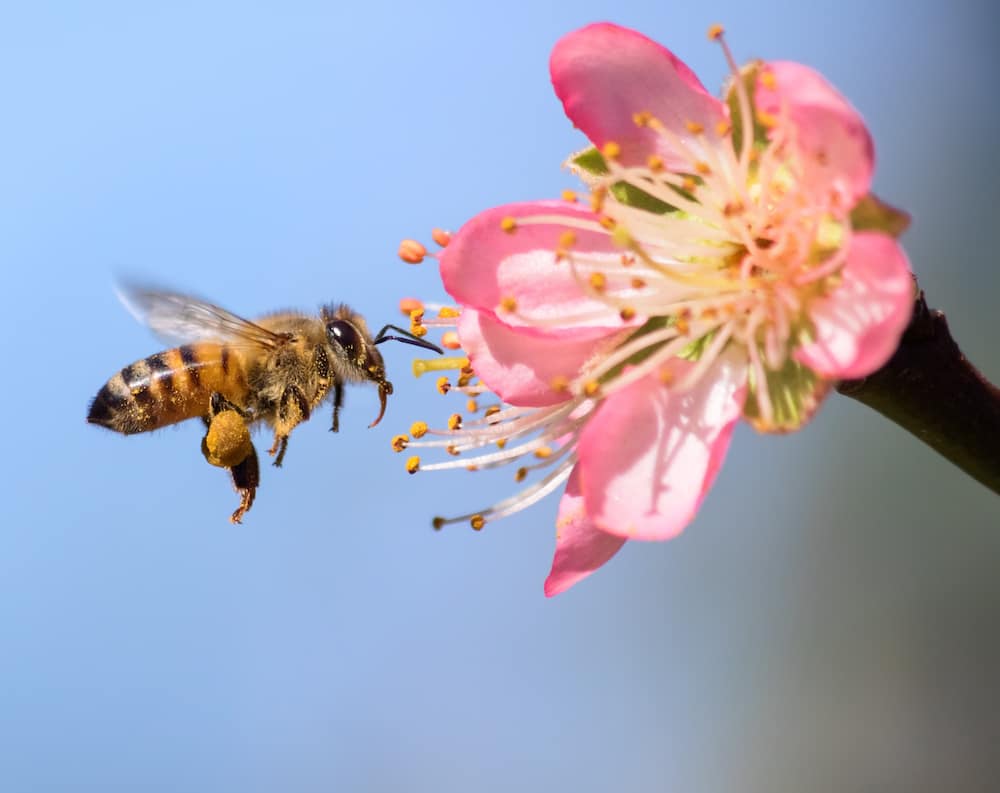
Description: Honeybees are not native to America but were imported by European settlers. These sweet bees are about 1/2 inch (12.7mm) long and are tan with differing degrees of orange and brown stripes. They are less furry and much smaller than bumblebees. The females carry the pollen in little concave baskets on their back legs rather than in a dense brush of hair like squash bees do. Honeybees have 4 wings – 2 on each side.
Habitats – Social bees: Honeybees are ruled by a queen. Their habitats are in tree hollows (in the wild) or in wooden boxes managed by beekeepers. They construct their nests out of the wax that secretes from glands in their abdomens.
Pollination: Honeybees are considered the number 1 pollinating bee although Bumblebees along with many solitary bees are incredibly efficient as well.
The Honey: Only honeybees make the honey we all so love. Other bees can make very small amounts but it’s mostly only to feed their young larvae in the cells. In addition to clover honey that you can find everywhere, there are many other varieties of honey such as acacia, orange blossom, tupelo, saw palmetto, lavender, and the list goes on. Check out Savannah Bee Company – this is one of my favorite places in the United States to find incredible honey from around the world.
Do Honeybees sting? Yes, but generally only in self-defense or in defense of the hive. The internet is full of photos showing people that let an entire hive land on them without getting stung. Just don’t freak them out and you’ll be fine. Honeybees are the only bees to die after stinging. This is because they have barbed stingers and once having stung, they are unable to pull their stinger out resulting in the bee ripping off part of its lower abdomen in an attempt to set itself free.
5. Leafcutter bee (genus: Megachile)
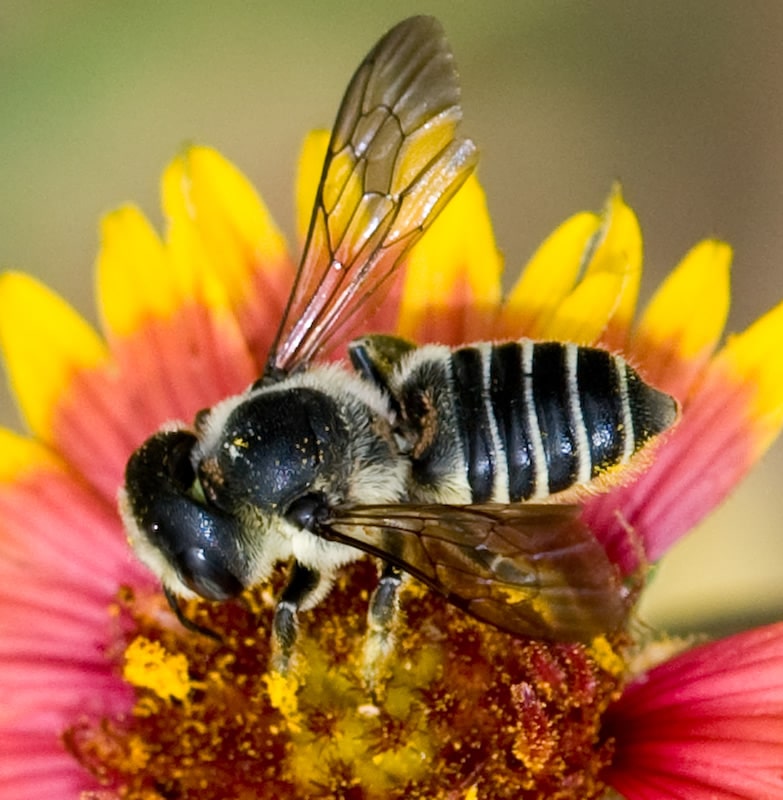
Megachili Leaf Cutter Bee. Image by Jim McCulloch U.S. Forest Service website.
Description: There are over 242 different species of Megachili Cutter bees. The Megachili Leaf Cutter bee (above) and the Mason bee (below) are part of a larger group of leaf cutting bees. The Megachili Leaf Cutter Bee (above) has a black body with blond fur and is about the size of a honeybee.
Habitats – Solitary: Leaf cutter bees make their nests in hollow wood and empty stems. Some will nest underground in skinny tubes no bigger around than a pencil. These tunnels will lead to her larvae which are fed a kind of bee loaf that the mother makes with pollen and her own saliva. Once there is enough of this loaf she then lays an egg on top of it and seals the cell with chewed up leaves. When the egg has grown into an adult, it will chew its way out, mate, and start the whole cycle over again. These are great bees to attract to your own garden by building bee houses whose designs can be found everywhere on the internet.
Pollination: Leaf Cutter bees don’t carry pollen on their back legs like most bees but instead collect it on their fuzzy bellies. They are very efficient pollinators of not only wildflowers but alfalfa, blueberries, onions, carrots and other fruits and vegetables. They have been known to be better at pollinating alfalfa than honeybees and have even been employed for this very purpose. They are noted for cutting circular holes in leaves,
Do Leaf Cutter bees sting? Here again, they are not aggressive but will sting in self-defense. Their sting is mild and much less painful than that of a honeybee or wasp.
6. Mason Bee (genus: Osmia)
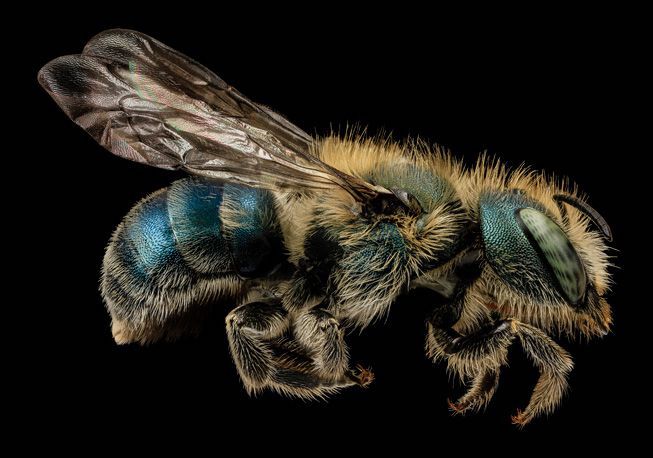
Blue Orchard Mason Bee Photo by: (Photo: USGS Bee Inventory and Monitoring Lab/Flickr)
Description: Mason bees are small – about the size of a honeybee and some resemble the honeybee in color except their fur looks a little more unkept. But they also come in metallic blue-green which are more commonly known as blue orchard bees, as well as a red in color called Red Mason Bees .
Habitats – Solitary Bees: Mason bees are solitary bees who prefer to make their nests in cavities and tubes. However, they don’t dig their own nests, instead they’ll construct them in abandoned nests of wood-boring insects like carpenter bees, in bamboo, reeds, bark, or under any protected space really. They are named “Mason” bees because of their use of mud (as in masonry), to pack around their eggs and in order to seal their nests. Every female is her own queen. They are born fertile and there are no workers in the nests.
Pollination: Mason bees are incredible pollinators due to their sloppy pollen collecting methods. Where as the honeybee (and others) collect the pollen and neatly tuck it on their legs or bellies, the Mason bee will go from flower to flower and just get pollen all over their bodies. This actually works out wonderfully when visiting each flower as the pollen will fall off of them just as easily. Mason bees have a 95% rate of pollination in contrast to 5% pollination coverage of the honeybees. Orchards need fewer mason bees to pollinate per acre than they would with honeybees.
Do Mason Bees Make Honey? Mason bees do not make honey. They only collect nectar and pollen to feed themselves throughout their life.
Do Mason Bees sting? Female Mason bees are very gentle and rarely sting unless attacked or stepped on, and the males have no stinger at all. They’re great to have in gardens if you have kids or pets. You can even built little hotels for them.
7. Squash bees (genera: Peponapis and Xenoglossa)

Squash Bee – peponapis. Photo: Adobe Stock
Description: Squash bees have a brown body covered in a light colored hair on the thorax with striped bands on their abdomens. They are a medium sized bee growing to up to 1/2 inch (12.7mm) long. These bees have evolved into very early risers and have an interesting daily habit of flying before sunrise. This works in their favor as squash and gourd blossoms open early in the morning. Females collect the pollen on the brushes of hair on their back legs. During the morning hours, male squash bees can be seen flying from blossom to blossom looking for love… by noon they can be found sleeping at the bottom of the wilted flowers.
Habitats – Solitary: Squash bees are underground nesting bees who make their tunnels about a foot or so underground. Because they prefer to make their nests a little too close to their food source – under the squash plants – this makes them extremely vulnerable to being tilled up. Squash bees make their nests in a series of underground tunnels. At the end of each tunnel are cells that are filled with pollen and eggs. Like most solitary bees they have one generation per year.
Pollination: Originally from Mexico, Squash bees are incredible pollinators of squash, pumpkin, and other gourds. It has been suggested that they would be an inexpensive and highly effective alternative to honeybees that are currently being used for pollinating pumpkin, squash and gourd fields.
Do Squash bees sting? These gentle bees can sting but prefer not to unless provoked. The male has no stinger and the female prefers to fly away rather than fight.
8. Sweat bees (various genera)
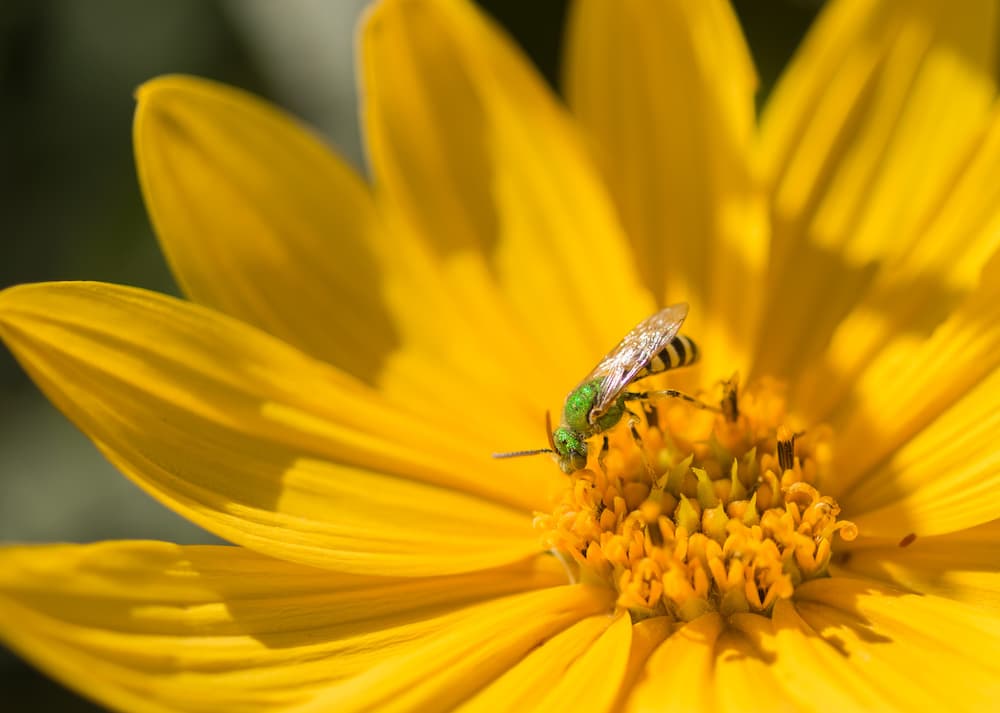
Description: Sweat bees are small ranging from 1/4 – 1/2 inch (1.27mm – 3.17mm) long. Their name is due to their attraction to human sweat. Most sweat bees are metallic looking and come in shades of blue-green, blue-bronze, and some are even a dull metallic black color.
Habitats – Social and Solitary: Sweat bees are ground nesting bees preferring to live in burrows under the soil. Depending on the species they can be both Solitary and Eusocial. The Solitary bees live in individual cells which are far apart from each other. The Eusocial bees live in individual cells but are close to one another. In colonies that are eusocial, the mated female Sweat bee is the queen. She will burrow into the ground and dig out cells to lay eggs in. She will fill the cell with pollen and lay an egg inside of it. Once hatched, only worker bees will emerge. The male’s only job is to mate with females.
Pollination: Females carry the pollen on the backs of their legs while males do not. They have been known to pollinate sunflowers, stone-fruits, alfalfa and wildflowers. While not as glamorous as the honeybee or bumblebee they are important pollinators to the native plants in the areas they inhabit.
Do Sweat Bees sting? Sweat bees have the least painful of all the stinging insects according to the Schmidt Sting Pain Index. They are non-aggressive and once again will only sting if handled or stepped on.
In Summary
So, there you have it. There are many bees that pollinate a variety of crops. If we’re good to them, they’ll be good to us.
Support Your Local Bees and Beekeepers.
They Keep Our Lives Sweet.
Views: 259
